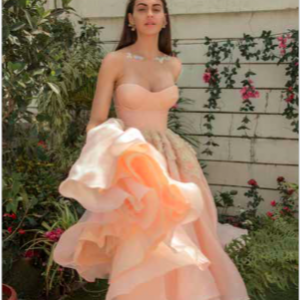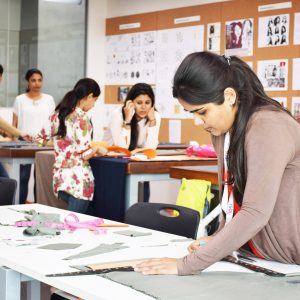Have you ever watched alluring dressmaking and sewing videos on Instagram? Watched skilled hands layer fabric on mannequins; attach beads, jewels, drapes, and feathers? Did that inspire you to design your dresses? Maybe you loved dressing up your dolls or siblings as a child? Cut up fabric to make your dress for your model, even at the risk of being scolded for snipping up a perfectly wearable t-shirt before tossing it out. If so, this article is for you!
We’ll discover one aspect of fashion: couture, sewing, and dressmaking. Join us to learn what couture is and the various sewing techniques that encompass it! Excited? Then without further ado, let’s dive right in!
What is Haute Couture?
Elite, the crème de la crème of fashion, haute couture is the production of unique, handcrafted, high-end, custom-fitted clothing from start to finish. The focus here is on craftsmanship, and the attention to detail is simply mind-boggling. Haute couture clothing is for specific customers, taking into account their proportions and body structure. The budget is irrelevant: phenomenal amounts of time, money, and talent are infused into each piece.

It would not surprise you that the words “haute couture” translate to “high dressmaking” in French.
Imagine mid-nineteenth-century Paris blowing up as the hottest destination for an industry of designers specialising in making high-quality and expensive gowns, made of unique fabrics emphasising the details. All are painstakingly designed by hand. If you have watched “Bridgeton”, you know that only aristocrats and the wealthy used these. Today haute couture is synonymous with classy apparel, popularised by celebrities.
Here’s a fun fact: Marylin Monroe’s scandalous happy birthday dress is a leading example of haute couture. It was practically sewn onto her, made solely for her body. The history associated with the dress and its magnificence caused an absolute uproar when Kim Kardashian wore it to the Met Gala. Have you been keeping up with the drama?

Now that you are all caught up on the yore, let’s jump right into couture dress-making and sewing techniques.
Haute Couture: Dress-Making and Sewing Techniques
Flawless craftsmanship is a characteristic of haute couture. It begins even before the cloth is cut. Plan the design by accounting for the following characteristics:
- What is the theme of the dress?
- How should it match the aura of the model? (psst! Want a quick guide on putting together a design? Check this out!)
- What motifs, designs, and colours would work on the model?
- Where should the elements of the dress be positioned to suit the model’s body type?
Then the construction process runs, and all handmade stitches (permanent and temporary), hold the garment together. They are taken out and sewed differently, put together, and pulled apart until the garment becomes the artist’s vision- like clay.
The best part is sewing, which begins now! Anyone with basic sewing knowledge can work with the following techniques to make art:
-
Muslin
This is what the “test garment” is. You use this to fine-tune your design and check that the pattern works before you begin. First, start from the bodice and cut your muslin into the natural shapes of the dress, with seam allowances at 1”.

- Mark out your ground
Use chalk or thread to put down your marks, like a painter would use crayons to mark out the shapes of an object. - Zip it up
For zippers, use backstitches (overlapping stitches) for strengths, and then use different fabrics to cover and overlay your zipper. - Hem away
Hems are often challenging to get straight, especially when hand stitching. The solution to the perfect hem is simple. Cut a facing (a facing is an extra cloth either from the “raw” ends of the article or another material sewn together to give the piece a finished look) in the skirt shape. Make it at least 4” above the bottom of the skirt, then stitch them together, the lower edge of the facing against the lower edge of the dress and the higher edge of each against one other. Use under-stitches for finesse, and iron the piece once done for that flawless hem. - Underline
Use silk organza to serve as the foundation to your dress to keep it from wrinkling and give your dress structure. Remember: well-made garb is made from the inside out, so the foundation is essential!
These techniques are just the beginning. There is a world of couture to experience, delightful fabrics, charming motifs, shiny beads, and fluffy feathers, all waiting for your touch!
Fun Fact: Studies suggest that fashion colours, cuts and patterns tend to have a positive effect on our brains. For the best effect, one should conduct periodic dress-up rituals, to stave off thoughts related to anxiety and depression.
Sewing and designing can be fun for those interested in it, but the sky’s the limit for the dedicated! Not only is it lucrative, but it also has many career opportunities open, ranging from account managers and designers to even personal shoppers. The world of haute couture is gorgeous and glamorous, and the proper guidance is necessary for any student to shine here.
How can ISDI help:
ISDI offers various design programs such as Strategic Design Management, Product Design Fashion Design, Fashion Communication and Styling, Interior Design and Strategic Design, Communication Design, and Management. Pursuing one of the degree programs, that is, Bachelors in Design (BDes) – 4-year program or Postgraduate In Design (PGDI) – 11 months program. Either of the programs is an alternative to a career in fashion and design.
The ISDI campus is located in the business district of Mumbai, the commercial centre of India. ISDI consists of a curriculum that is based on that of the Parsons School of Design, experienced and industry-leading faculty, and practical project-based training, all situated on a state-of-the-art campus. ISDI is just the right place for someone looking to start a career in design.









